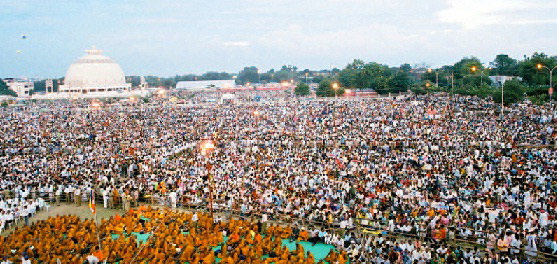New Delhi, India — Every year a million Dalits gather at the site of the first Conversion to Buddhism in Nagpur, India. Since 1956 millions of Dalits have responded to Dr. Ambedkar’s appeal to adopt Buddhism and escape the caste system.

Today in thousands of villages and towns the homes of Dalit people have shrines with pictures of the Buddha and Dr. Ambedkar – a man they revere as a Bodhisattva. Each October over a million Dalit Buddhists come to Nagpur to rally at the site of the original conversion.
In spite of their poverty and lack of education and resources, the new Indian Buddhists are working to create a just society and develop their understanding of the Dharma. In many places temples, meditation centers and social projects have been developed, and new generations of young Buddhists are working to realize Dr. Ambedkar’s vision of social justice and personal growth based on the ancient teachings of the Buddha.
Peaceful Buddhist Revolution
India is the scene of an extraordinary social movement. Inspired by one of the 20th Century’s most extraordinary reformers, millions of people from the lowest sections of society have converted to Buddhism and are leaving behind the stigma and oppression of the Caste system.
Caste Oppression
The Caste system is the oldest and most entrenched system of social oppression in the world today. Indian society is divided into thousands of communities according to a hierarchical system of ‘graded inequality’ that stigmatizes people for life based on their birth.
Between 160 and 200 million people in India belong to the Dalit community, the lowest social group also known as the “Untouchables.” According to the Caste system these people are deemed to be impure – less than human. They are forced to do the worst kinds of menial labor such as cleaning human waste, and they are subject to profound economic exploitation, poverty, discrimination and violence.
According to Human Rights Watch, “India’s Untouchables are relegated to the lowest jobs, and live in constant fear of being publicly humiliated, paraded naked, beaten, and raped with impunity by upper-caste Hindus seeking to keep them in their place. Merely walking through an upper-caste neighborhood is a life-threatening offense.“
Dr. Ambedkar and Buddhism
Dr. Bhimrao Ambedkar, the great leader of the Dalits, was determined to liberate people from poverty, injustice and caste oppression. Between 1923 and 1956 he worked tirelessly in the Indian political system as an advocate for human rights, and rose to become the first Law Minister of the new Indian nation and the chief author of its Constitution. The new Constitution made untouchability illegal, but Dr. Ambedkar came to believe that true social change could only come by leaving behind the cultural and religious beliefs that justified the caste system. In 1956, shortly before his death, he initiated a wave of mass conversions to Buddhism – a spiritual tradition free of prejudice.
A Dhamma Revolution
Today the peaceful Buddhist revolution is spreading throughout India. With few resources, and facing formidable obstacles from the established social system, people from the Dalit community are working to improve their living conditions, realize the civil rights promised by the Indian Constitution, and live with dignity free of caste oppression. They are establishing social and health programs, educational programs, hostels and community centers all over India.
Dr. Ambedkar believed that the teachings and values of the Buddhist tradition are the essential foundation for a successful, non-violent transformation of Indian society. Today his followers are working to put the Buddha’s teachings into practice as a living spiritual tradition that balances personal development with positive social engagement.
Participants in the Buddhist revival movement have a variety of approaches, ranging from an emphasis on spiritual practice to a focus on social transformation. Some people are committed to Dharma teaching and practice, and others are involved in community organizing, social work and education.
The following organizations illustrate the variety of activities that make up the broad-based Buddhist revival movement:
Nagaloka CenterNagaloka Center – www.nagaloka.org
Nagaloka is a training center for Buddhist activists located near Nagpur. It operates a ten-month residential course that has provided instruction in meditation, Dharma and community organizing to over 600 young people since 2001. Nagaloka is also a conference center that has hosted well-known Buddhist teachers, such as the Dalai Lama and Thich Nhat Hahn. Each year thousands of pilgrims visit the Walking Buddha statue at the center of the Nagaloka campus.
Triratna Bauddha MahasanghaTriratna Bauddha Mahasangha
Since 1972 this Buddhist sangha has reached hundreds of thousands of people through its meditation and Dharma classes, public talks, health centers, pre-schools and hostels for boys and girls. Affiliated with the international Triratna Buddhist Order, it is committed to realizing Ambedkar’s vision of the Dharma as a means of personal and social transformation.
National Network of Buddhist Youth
NNBY is a organization of underprivileged young people who have left behind their caste identity and work together as a mutual support network emphasizing education, peer support, social responsibility and ethical living.
Youth Buddhist Society
Established in 1986 in Northern India, YBS is a non-profit grassroots organization that works on poverty and social problems in thousands of poor villages. YBS sponsors Dharma talks, educational programs, peace marches and the construction of community centers.
Manuski InstituteManuski Institute – www.manuski.org
Manuski works to transcend caste barriers through social development programs and legal interventions against discrimination. The staff at Manuski is also working to develop leadership among Dalit women and create bridges between different Dalit groups and organizations. Manuski has been very successful at bringing international attention to incidents of extreme violence targeting Dalit people in India.
– By Diksha Bhumi
– Source : www.buddhistchannel.tv




